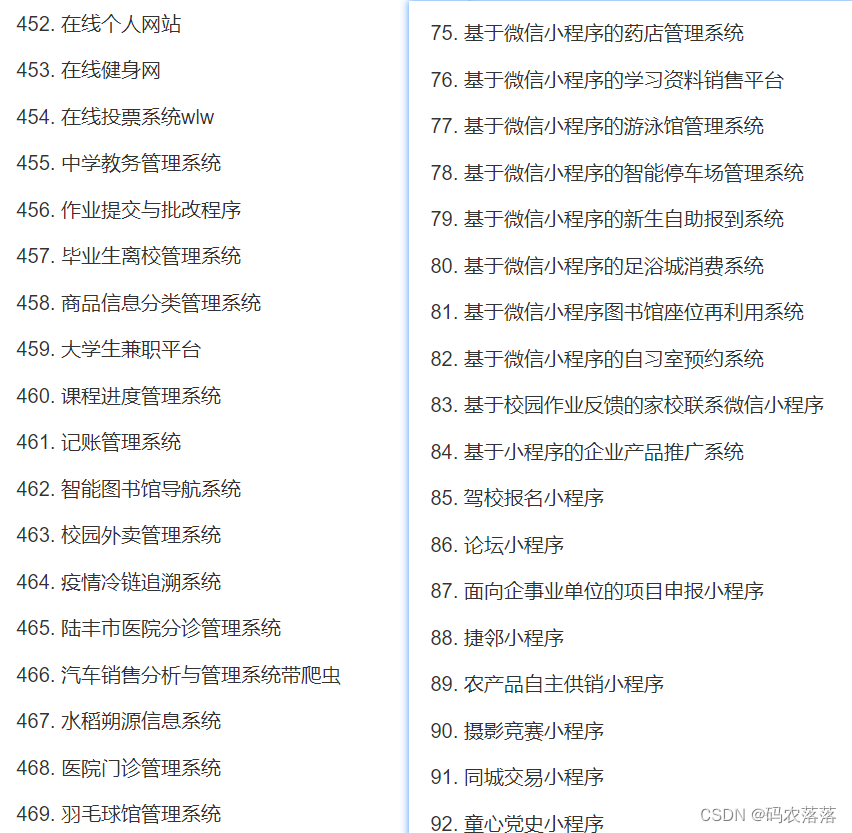
目录
- 一、【MLLAttention】注意力机制
- 1.1【MLLAttention】注意力介绍
- 1.2【MLLAttention】核心代码
- 二、添加【MLLAttention】注意力机制
- 2.1STEP1
- 2.2STEP2
- 2.3STEP3
- 2.4STEP4
- 2.5STEP5
- 三、yaml文件与运行
- 3.1yaml文件
- 3.2运行成功截图
一、【MLLAttention】注意力机制
1.1【MLLAttention】注意力介绍

下图是【MLLAttention】的结构图,让我们简单分析一下运行过程和优势
处理过程:
- MLLA Block:
- MLLA 模块的核心是其线性注意力机制,输入首先通过一个 线性变换(Linear),对输入特征进行降维或转化。
- 接着,线性注意力(Linear Attention) 被应用在变换后的特征上。线性注意力的主要特点是其计算复杂度低,能够快速处理长序列特征。这一层通过简单的线性变换替代了复杂的自注意力机制,提升了效率。
- 之后,特征会进一步通过 卷积(Conv) 和其他线性层进行细粒度的特征提取。这些操作确保特征在局部范围内也能够被有效捕捉和处理。
- 前馈网络(MLP):
- 在经过 MLLA Block 的处理后,特征会经过一个多层感知器(MLP)网络。MLP 网络通过非线性激活函数(例如 ReLU 或 GELU)来增强模型的非线性表达能力。
- 归一化(Norm) 层则用于对每一层输出的特征进行标准化处理,确保特征的稳定性,有助于模型更快收敛。
- 残差连接:
- 每个模块之间存在残差连接(Residual Connection),保证了在深层网络中,输入信息不会因为层数过深而消失。这种设计使得梯度更容易传播,提升了训练的稳定性和效率。
优势: - 计算效率高:
- 线性注意力机制的引入极大地降低了计算复杂度。相比传统的自注意力(如 Transformer 中的全局自注意力)依赖矩阵乘法和大规模计算,线性注意力能够以更低的计算成本完成类似的操作,非常适合处理大规模数据或长序列输入。
- 结合局部和全局特征:
- 通过将卷积层和线性层结合,MLLA 模块能够同时处理局部和全局特征。卷积层擅长捕捉局部空间关系,而线性层则负责处理全局特征的交互,从而提升了模型对多维度信息的捕捉能力。
- 增强的非线性表达能力:
- MLP 部分通过多层非线性变换,增强了模型的表达能力。这使得模型不仅能够处理线性关系,还能够处理更复杂的特征模式,从而提升模型的预测精度。
- 稳定的梯度传播:
- 残差连接的使用确保了模型在深度网络中的训练稳定性,有助于缓解梯度消失问题。对于深层网络来说,这种设计可以有效提高收敛速度和模型性能。

1.2【MLLAttention】核心代码
import torch
import torch.nn as nn
class Mlp(nn.Module):
def __init__(self, in_features, hidden_features=None, out_features=None, act_layer=nn.GELU, drop=0.):
super().__init__()
out_features = out_features or in_features
hidden_features = hidden_features or in_features
self.fc1 = nn.Linear(in_features, hidden_features)
self.act = act_layer()
self.fc2 = nn.Linear(hidden_features, out_features)
self.drop = nn.Dropout(drop)
def forward(self, x):
x = self.fc1(x)
x = self.act(x)
x = self.drop(x)
x = self.fc2(x)
x = self.drop(x)
return x
class ConvLayer(nn.Module):
def __init__(self, in_channels, out_channels, kernel_size=3, stride=1, padding=0, dilation=1, groups=1,
bias=True, dropout=0, norm=nn.BatchNorm2d, act_func=nn.ReLU):
super(ConvLayer, self).__init__()
self.dropout = nn.Dropout2d(dropout, inplace=False) if dropout > 0 else None
self.conv = nn.Conv2d(
in_channels,
out_channels,
kernel_size=(kernel_size, kernel_size),
stride=(stride, stride),
padding=(padding, padding),
dilation=(dilation, dilation),
groups=groups,
bias=bias,
)
self.norm = norm(num_features=out_channels) if norm else None
self.act = act_func() if act_func else None
def forward(self, x: torch.Tensor) -> torch.Tensor:
if self.dropout is not None:
x = self.dropout(x)
x = self.conv(x)
if self.norm:
x = self.norm(x)
if self.act:
x = self.act(x)
return x
class RoPE(torch.nn.Module):
def __init__(self, base=10000):
super(RoPE, self).__init__()
self.base = base
def generate_rotations(self, x):
# 获取输入张量的形状
*channel_dims, feature_dim = x.shape[1:-1][0], x.shape[-1]
k_max = feature_dim // (2 * len(channel_dims))
assert feature_dim % k_max == 0, "Feature dimension must be divisible by 2 * k_max"
theta_ks = 1 / (self.base ** (torch.arange(k_max, dtype=x.dtype, device=x.device) / k_max))
angles = torch.cat([t.unsqueeze(-1) * theta_ks for t in
torch.meshgrid([torch.arange(d, dtype=x.dtype, device=x.device) for d in channel_dims],
indexing='ij')], dim=-1)
rotations_re = torch.cos(angles).unsqueeze(dim=-1)
rotations_im = torch.sin(angles).unsqueeze(dim=-1)
rotations = torch.cat([rotations_re, rotations_im], dim=-1)
return rotations
def forward(self, x):
rotations = self.generate_rotations(x)
x_complex = torch.view_as_complex(x.reshape(*x.shape[:-1], -1, 2))
pe_x = torch.view_as_complex(rotations) * x_complex
return torch.view_as_real(pe_x).flatten(-2)
class MLLAttention(nn.Module):
def __init__(self, dim=3, input_resolution=[160, 160], num_heads=4, qkv_bias=True, **kwargs):
super().__init__()
self.dim = dim
self.input_resolution = input_resolution
self.num_heads = num_heads
self.qk = nn.Linear(dim, dim * 2, bias=qkv_bias)
self.elu = nn.ELU()
self.lepe = nn.Conv2d(dim, dim, 3, padding=1, groups=dim)
self.rope = RoPE()
def forward(self, x):
x = x.reshape((x.size(0), x.size(2) * x.size(3), x.size(1)))
b, n, c = x.shape
h = int(n ** 0.5)
w = int(n ** 0.5)
# self.rope = RoPE(shape=(h, w, self.dim))
num_heads = self.num_heads
head_dim = c // num_heads
qk = self.qk(x).reshape(b, n, 2, c).permute(2, 0, 1, 3)
q, k, v = qk[0], qk[1], x
# q, k, v: b, n, c
q = self.elu(q) + 1.0
k = self.elu(k) + 1.0
q_rope = self.rope(q.reshape(b, h, w, c)).reshape(b, n, num_heads, head_dim).permute(0, 2, 1, 3)
k_rope = self.rope(k.reshape(b, h, w, c)).reshape(b, n, num_heads, head_dim).permute(0, 2, 1, 3)
q = q.reshape(b, n, num_heads, head_dim).permute(0, 2, 1, 3)
k = k.reshape(b, n, num_heads, head_dim).permute(0, 2, 1, 3)
v = v.reshape(b, n, num_heads, head_dim).permute(0, 2, 1, 3)
z = 1 / (q @ k.mean(dim=-2, keepdim=True).transpose(-2, -1) + 1e-6)
kv = (k_rope.transpose(-2, -1) * (n ** -0.5)) @ (v * (n ** -0.5))
x = q_rope @ kv * z
x = x.transpose(1, 2).reshape(b, n, c)
v = v.transpose(1, 2).reshape(b, h, w, c).permute(0, 3, 1, 2)
x = x + self.lepe(v).permute(0, 2, 3, 1).reshape(b, n, c)
x = x.transpose(2, 1).reshape((b, c, h, w))
return x
def extra_repr(self) -> str:
return f'dim={self.dim}, num_heads={self.num_heads}'
if __name__ == "__main__":
# Generating Sample image
image_size = (1, 64, 160, 160)
image = torch.rand(*image_size)
# Model
model = MLLAttention(64)
out = model(image)
print(out.size())
二、添加【MLLAttention】注意力机制
2.1STEP1
首先找到ultralytics/nn文件路径下新建一个Add-module的python文件包【这里注意一定是python文件包,新建后会自动生成_init_.py】,如果已经跟着我的教程建立过一次了可以省略此步骤,随后新建一个MLLAttention.py文件并将上文中提到的注意力机制的代码全部粘贴到此文件中,如下图所示
2.2STEP2
在STEP1中新建的_init_.py文件中导入增加改进模块的代码包如下图所示
2.3STEP3
找到ultralytics/nn文件夹中的task.py文件,在其中按照下图添加
2.4STEP4
定位到ultralytics/nn文件夹中的task.py文件中的def parse_model(d, ch, verbose=True): # model_dict, input_channels(3)函数添加如图代码,【如果不好定位可以直接ctrl+f搜索定位】

2.5STEP5
这个模块有点特殊,需要在moels/yolo/detect/val.py文件下做修改,不然验证的时候会出错

return build_yolo_dataset(self.args, img_path, batch, self.data, mode=mode, rect=False, stride=self.stride)
注意替换后运行完这个模块后记得还原
三、yaml文件与运行
3.1yaml文件
以下是添加【MLLAttention】注意力机制在Backbone中的yaml文件,大家可以注释自行调节,效果以自己的数据集结果为准
# Ultralytics YOLO 🚀, AGPL-3.0 license
# YOLO11 object detection model with P3-P5 outputs. For Usage examples see https://docs.ultralytics.com/tasks/detect
# Parameters
nc: 80 # number of classes
scales: # model compound scaling constants, i.e. 'model=yolo11n.yaml' will call yolo11.yaml with scale 'n'
# [depth, width, max_channels]
n: [0.50, 0.25, 1024] # summary: 319 layers, 2624080 parameters, 2624064 gradients, 6.6 GFLOPs
s: [0.50, 0.50, 1024] # summary: 319 layers, 9458752 parameters, 9458736 gradients, 21.7 GFLOPs
m: [0.50, 1.00, 512] # summary: 409 layers, 20114688 parameters, 20114672 gradients, 68.5 GFLOPs
l: [1.00, 1.00, 512] # summary: 631 layers, 25372160 parameters, 25372144 gradients, 87.6 GFLOPs
x: [1.00, 1.50, 512] # summary: 631 layers, 56966176 parameters, 56966160 gradients, 196.0 GFLOPs
# YOLO11n backbone
backbone:
# [from, repeats, module, args]
- [-1, 1, Conv, [64, 3, 2]] # 0-P1/2
- [-1, 1, Conv, [128,3,2]] # 1-P2/4
- [-1, 2, C3k2, [256, False, 0.25]]
- [-1, 1, Conv, [256,3,2]] # 3-P3/8
- [-1, 2, C3k2, [512, False, 0.25]]
- [-1, 1, Conv, [512,3,2]] # 5-P4/16
- [-1, 2, C3k2, [512, True]]
- [-1, 1, Conv, [1024,3,2]] # 7-P5/32
- [-1, 2, C3k2, [1024, True]]
- [-1, 1, SPPF, [1024, 5]] # 9
- [-1,1,MLLAttention,[]]
- [-1, 2, C2PSA, [1024]] # 10
# YOLO11n head
head:
- [-1, 1, nn.Upsample, [None, 2, "nearest"]]
- [[-1, 6], 1, Concat, [1]] # cat backbone P4
- [-1, 2, C3k2, [512, False]] # 13
- [-1, 1, nn.Upsample, [None, 2, "nearest"]]
- [[-1, 4], 1, Concat, [1]] # cat backbone P3
- [-1, 2, C3k2, [256, False]] # 16 (P3/8-small)
- [-1, 1, Conv, [256, 3, 2]]
- [[-1, 14], 1, Concat, [1]] # cat head P4
- [-1, 2, C3k2, [512, False]] # 19 (P4/16-medium)
- [-1, 1, Conv, [512, 3, 2]]
- [[-1, 11], 1, Concat, [1]] # cat head P5
- [-1, 2, C3k2, [1024, True]] # 22 (P5/32-large)
- [[17, 20, 23], 1, Detect, [nc]] # Detect(P3, P4, P5)
以上添加位置仅供参考,具体添加位置以及模块效果以自己的数据集结果为准
3.2运行成功截图

OK 以上就是添加【MLLAttention】注意力机制的全部过程了,后续将持续更新尽情期待

![[Linux#66][TCP->IP] 面向字节流 | TCP异常 | filesocket | 网络层IP](https://img-blog.csdnimg.cn/img_convert/f4981d51a9dfd09196d9190c117f865d.jpeg)

















